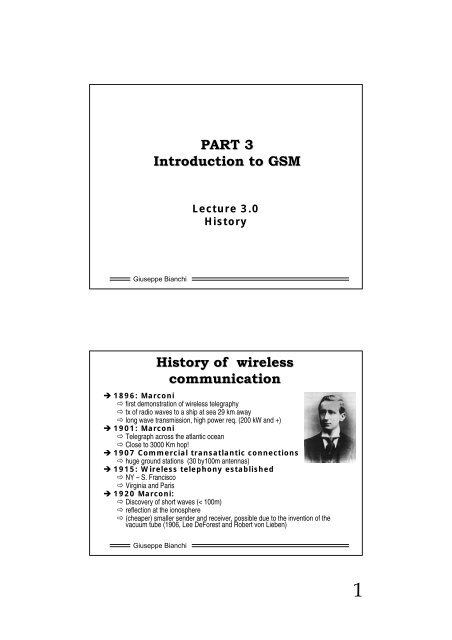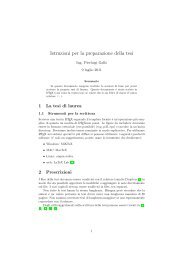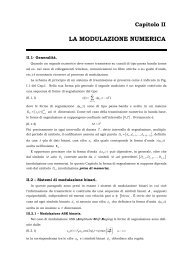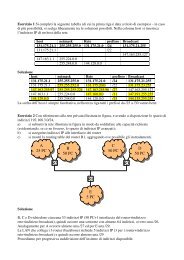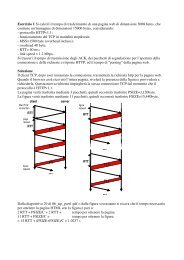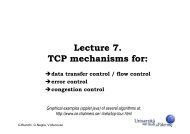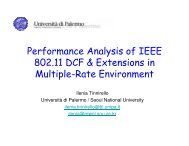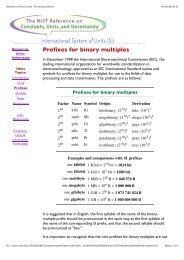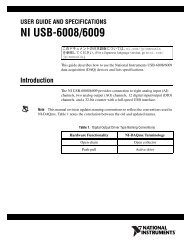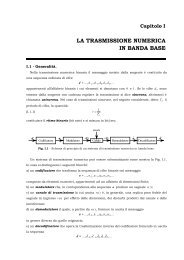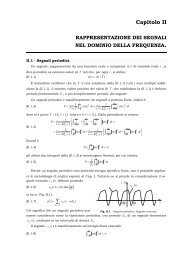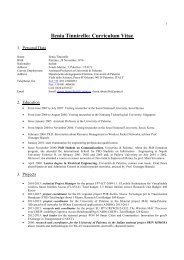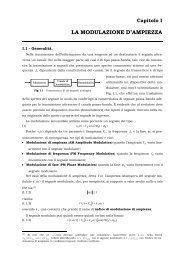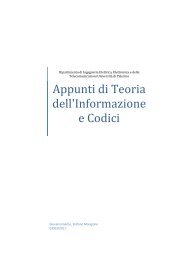PART 3 Introduction to GSM History of wireless communication
PART 3 Introduction to GSM History of wireless communication
PART 3 Introduction to GSM History of wireless communication
Create successful ePaper yourself
Turn your PDF publications into a flip-book with our unique Google optimized e-Paper software.
<strong>PART</strong> 3<br />
<strong>Introduction</strong> <strong>to</strong> <strong>GSM</strong><br />
Giuseppe Bianchi<br />
Giuseppe Bianchi<br />
Lecture 3.0<br />
His<strong>to</strong>ry<br />
His<strong>to</strong>ry <strong>of</strong> <strong>wireless</strong><br />
<strong>communication</strong><br />
� 1896: Marconi<br />
� first demonstration <strong>of</strong> <strong>wireless</strong> telegraphy<br />
� tx <strong>of</strong> radio waves <strong>to</strong> a ship at sea 29 km away<br />
� long wave transmission, high power req. (200 kW and +)<br />
� 1901: Marconi<br />
� Telegraph across the atlantic ocean<br />
� Close <strong>to</strong> 3000 Km hop!<br />
� 1907 Commercial transatlantic connections<br />
� huge ground stations (30 by100m antennas)<br />
� 1915: Wireless telephony established<br />
� NY – S. Francisco<br />
� Virginia and Paris<br />
� 1920 Marconi:<br />
� Discovery <strong>of</strong> short waves (< 100m)<br />
� reflection at the ionosphere<br />
� (cheaper) smaller sender and receiver, possible due <strong>to</strong> the invention <strong>of</strong> the<br />
vacuum tube (1906, Lee DeForest and Robert von Lieben)<br />
1
His<strong>to</strong>ry <strong>of</strong> <strong>wireless</strong><br />
<strong>communication</strong><br />
� 1920's: Radio broadcasting became popular<br />
� 1928: many TV broadcast trials<br />
� 1930's: TV broadcasting deployment<br />
� 1946: First public mobile telephone service in US<br />
� St. Louis, Missouri<br />
� Single cell system<br />
� 1960's: Bell Labs developed cellular concept<br />
� brought mobile telephony <strong>to</strong> masses<br />
� 1960’s: Communications satellites launched<br />
� Late 1970's: technology advances enable<br />
affordable cellular telephony<br />
� entering the modern cellular era<br />
� 1974-1978: First field Trial for Cellular System<br />
� AMPS, Chicago<br />
Giuseppe Bianchi<br />
1st generation mobile systems<br />
early deployment<br />
�First system:<br />
� NMT-450 (Nordic Mobile Telephone)<br />
�Scandinavian standard; adopted in most <strong>of</strong> Europe<br />
�450 MHZ band<br />
�First european system (Sweden, oc<strong>to</strong>ber 1981)<br />
� Italian his<strong>to</strong>ry:<br />
� 1966: first experiments (CSELT) at 160 MHZ<br />
�RTMI (Radio Telefono Mobile Italiano)<br />
�Market: 1973<br />
� First italian cellular system: 1985<br />
�RTMS (Radio Telefono Mobile di Seconda Generazione)<br />
�450 MHZ<br />
� Evolution: 1990, TACS<br />
�Total Access Communication System<br />
�900 MHZ<br />
Giuseppe Bianchi<br />
2
1st generation mobile systems<br />
�First generation: 1980’s<br />
�Several competing standards in<br />
different countries<br />
� NMT (Nordic Mobile Telephone)<br />
�Scandinavian standard; adopted in most<br />
<strong>of</strong> Europe<br />
�First european system (Sweden, 1981)<br />
� TACS (Total Access Communication<br />
Systems), starts in 1985<br />
�UK standard; A few <strong>of</strong> Europe, Asia,<br />
Japan<br />
� AMPS (Advanced Mobile Phone<br />
Service)<br />
�US standard<br />
� C-Netz (Only in Germany)<br />
� Radiocom 2000 (Only in France)<br />
Giuseppe Bianchi<br />
Giuseppe Bianchi<br />
�Analog transmission<br />
� Frequency modulation<br />
�Various bands:<br />
� NMT:<br />
�450 MHz first<br />
�900 MHz later<br />
� TACS<br />
�900 MHz<br />
�1230 bidirectional<br />
channels (25KHz)<br />
� AMPS<br />
�800 MHz<br />
�Today still in use in lowtechnology<br />
countries<br />
� And not yet completely dismissed<br />
in high-tech countries<br />
2nd generation mobile systems<br />
�4 systems<br />
�Global System for Mobile (<strong>GSM</strong>)<br />
�Digital AMPS (D-AMPS), US<br />
�Code Division Multiple Access<br />
(IS-95) – Qualcomm,US<br />
�Personal Digital Cellular<br />
(PDC),Japan<br />
�<strong>GSM</strong> by far the<br />
dominant one<br />
�Originally pan-european<br />
�Deployed worldwide<br />
�(slow only in US)<br />
�Basic bands:<br />
�900 MHz<br />
�1800 MHz<br />
�(Digital Cellular System:<br />
DCS-1800)<br />
�1900 MHz<br />
�(Personal Communication<br />
System:PCS-1900,US only)<br />
�Specifications for<br />
�<strong>GSM</strong>-400 (large areas)<br />
�<strong>GSM</strong>-800 (north america)<br />
3
Giuseppe Bianchi<br />
Timing<br />
�1982: Start <strong>of</strong> <strong>GSM</strong>-specification in<br />
Europe (1982-1990)<br />
�1983: Start <strong>of</strong> American AMPS<br />
widespread deployment<br />
�1984 CT-1 standard (Europe) for<br />
cordless telephones<br />
�1991 Specification <strong>of</strong> DECT<br />
�Digital European Cordless Telephone (<strong>to</strong>day: Digital<br />
Enhanced Cordless Tele<strong>communication</strong>s)<br />
- ~100-500m range, 120 duplex channels, 1.2Mbit/s data<br />
transmission, voice encryption, authentication<br />
�1992: Start <strong>of</strong> <strong>GSM</strong> operation Europewide<br />
�1994: DCS-1800<br />
2 ½ generation mobile systems<br />
<strong>GSM</strong> incremental extension<br />
�High speed circuit switched data<br />
(HSCSD)<br />
�Circuit switched data <strong>communication</strong><br />
�Uses up <strong>to</strong> 4 slots (1 slot = 9.6 or 14.4 Kbps)<br />
�General Packet Radio Service (GPRS)<br />
�Packet data (use spectrum only when needed!)<br />
�Up <strong>to</strong> 115 Kbps (8 slots)<br />
�Enhanced Data-rates for Global Evolution<br />
(EDGE)<br />
�Higher data rate available on radio interface (3x)<br />
» Up <strong>to</strong> 384 Kbps (8 slots)<br />
» Thanks <strong>to</strong> new modulation scheme (8PSK)<br />
» May coexist with old GMSK<br />
Giuseppe Bianchi<br />
4
3rd generation mobile systems<br />
�UMTS (Universal Mobile<br />
Tele<strong>communication</strong>System)<br />
�ITU standard: IMT-2000 (International Mobile<br />
Tele<strong>communication</strong> – 2000)<br />
�UMTS forum created in 1996<br />
�Later on 3GPP forum (bears most <strong>of</strong> standardization<br />
activities)<br />
�Wideband CDMA radio interface<br />
�But several other proposals accepted as “compatible”<br />
�Radio spectrum: 1885-2025 & 2110-2200 MHz<br />
�Already deployed in Japan<br />
�Time <strong>to</strong> market in Italy: 2004?<br />
Giuseppe Bianchi<br />
Facts about <strong>wireless</strong><br />
<strong>communication</strong><br />
�Who has a cellular phone?<br />
�USA: Over 50% <strong>of</strong> US households<br />
�Italy: from 2001, more <strong>wireless</strong> lines than wired<br />
�World: from march 2002, 1 billion <strong>wireless</strong> cellular users<br />
�Much faster than projections!<br />
�August 2000: 372 <strong>GSM</strong> networks, 362M cus<strong>to</strong>mers<br />
�Revenues:<br />
�global revenue from <strong>wireless</strong> portals predicted <strong>to</strong> grow from<br />
$700M <strong>to</strong> $42 billion by 2005<br />
�WLAN revenues predicted at $785M by 2004<br />
�Forecasting a 59 percent growth rate for <strong>wireless</strong> usage in<br />
rural areas between 2000 and 2003<br />
Giuseppe Bianchi<br />
5
<strong>PART</strong> 3<br />
<strong>Introduction</strong> <strong>to</strong> <strong>GSM</strong><br />
Lecture 3.1<br />
Architecture and components<br />
Giuseppe Bianchi<br />
MSC<br />
Base<br />
Station<br />
<strong>GSM</strong> Network<br />
high-level high level view<br />
MSC = Mobile Switching Center<br />
= administrative region<br />
PSTN<br />
Public<br />
Public<br />
switched<br />
switched<br />
telephone<br />
telephone<br />
network<br />
network<br />
PLMN<br />
Public Land<br />
Mobile Network<br />
MSC<br />
Base<br />
Station<br />
MSC role: telephone switching central with special mobility management capabilities<br />
Giuseppe Bianchi<br />
6
LOCATION<br />
AREA<br />
BTS<br />
<strong>GSM</strong> system hierarchy<br />
BSC<br />
Giuseppe Bianchi<br />
MSC<br />
MSC region<br />
Hierarchy: MSC region � n x Location Areas � m x BSC � k x BTS<br />
To fixed network<br />
(PSTN, ISDN, PDN)<br />
<strong>GSM</strong> essential components<br />
BSC<br />
BTS<br />
MS<br />
GMSC<br />
BTS<br />
BTS<br />
Giuseppe Bianchi<br />
OMC<br />
MSC<br />
BTS<br />
BTS<br />
BSC<br />
MSC: Mobile Switching Center<br />
LA: Location Area<br />
BSC: Base Station Controller<br />
BTS: Base Transceiver Station<br />
EIR AUC HLR VLR<br />
MS Mobile Station<br />
BTS Base Transceiver Station<br />
BSC Base Station Controller<br />
MSC Mobile Switching Center<br />
GMSC Gateway MSC<br />
OMC Operation and Maintenance Center<br />
EIR Equipment Identity Register<br />
AUC Authentication Center<br />
HLR Home Location Register<br />
VLR Visi<strong>to</strong>r Location Register<br />
7
<strong>GSM</strong> Sub-Systems<br />
Sub Systems<br />
External<br />
Networks<br />
NSS<br />
opera<strong>to</strong>r<br />
OSS<br />
Giuseppe Bianchi<br />
� Two components:<br />
� Fixed installed infrastructure<br />
� The network in the proper sense<br />
� Mobile subscribers<br />
� MS: Mobile Station<br />
� Fixed infrastructure divided<br />
in<strong>to</strong> three sub-systems<br />
� BSS: Base Station subsystem<br />
� Manages transmission path from MS<br />
<strong>to</strong> NSS<br />
� NSS: Network Switching Subsystem<br />
� Communication and interconnection<br />
with other nets<br />
� OSS: Operational Subsystem<br />
� <strong>GSM</strong> network administration <strong>to</strong>ols<br />
BSS MS<br />
A Interface Radio Interface (Um)<br />
<strong>PART</strong> 3<br />
<strong>Introduction</strong> <strong>to</strong> <strong>GSM</strong><br />
Lecture 3.2<br />
Mobile Station and addresses<br />
Giuseppe Bianchi<br />
Users<br />
8
Mobile Station (MS)<br />
<strong>GSM</strong> separates user mobility from equipment mobility,<br />
by defining two distinct components<br />
�Mobile Equipment<br />
�The cellular telephone itself (or the vehicular telephone)<br />
�Address / identifier:<br />
�IMEI (International Mobile Equipment Identity)<br />
�Subscriber Identity Module (SIM)<br />
�Fixed installed chip (plug-in SIM) or<br />
�exchangeable card (SIM card)<br />
�Addresses / identifiers:<br />
�IMSI (International Mobile Subscriber Identity)<br />
�MSISDN (Mobile Subscriber ISDN number)<br />
» the telephone number!<br />
Giuseppe Bianchi<br />
Mobile Equipment structure<br />
Terminal<br />
Mobile<br />
Equipment<br />
Termination Terminal Terminal Mobile<br />
Equipment Adap<strong>to</strong>r Termination<br />
� Mobile Termination functions<br />
� tRadio interface (tx, rx, signalling)<br />
� Terminal Equipment functions<br />
� User interface (microphone,<br />
keyboard, speakers, etc);<br />
� Functions specific <strong>of</strong> services<br />
(telephony, fax, messaging, etc),<br />
independent <strong>of</strong> <strong>GSM</strong><br />
� Terminal Adap<strong>to</strong>r functions<br />
� Interfaces MT with different types<br />
<strong>of</strong> terminals (PCs, Fax, etc.)<br />
Giuseppe Bianchi<br />
Mobile Equipment<br />
TE1 MT<br />
R<br />
TE2 TA MT<br />
S<br />
U m<br />
9
Mobile Equipment Max Power<br />
CLASS<br />
I<br />
II<br />
III<br />
IV<br />
V<br />
Giuseppe Bianchi<br />
5 power classes<br />
max power<br />
(watt)<br />
20<br />
8<br />
5<br />
2<br />
0.8<br />
Type <strong>of</strong><br />
terminal<br />
vehicular<br />
vehicular<br />
portable<br />
portable<br />
portable<br />
Normally used<br />
This was for 900 MHz – for 1800 MHz only two classes: 1W, and 0.25 W<br />
Giuseppe Bianchi<br />
IMEI<br />
International Mobile Equipment Identity<br />
� Uniquely identifies the mobile equipment<br />
� 15 digits hierarchical address<br />
� assigned <strong>to</strong> ME during manifacturing and “type approval” testing<br />
� Type approval procedure: guarantees that the MS meets a<br />
minimum standard, regardless <strong>of</strong> the manifacturer<br />
� IMEI structure:<br />
TAC – 6 digits<br />
(Type Approval Code)<br />
centrally assigned<br />
upon type approval<br />
FAC – 2 digits<br />
(Final Assembly Code)<br />
assigned by<br />
manufacturer<br />
Identifies place<br />
where ME was<br />
assembled or<br />
manufactured<br />
SNR – 6 digits<br />
(Serial Number)<br />
assigned by<br />
manufacturer<br />
Unique for given<br />
TAC+FAC<br />
combination<br />
SP – 1 digit<br />
(Spare Digit)<br />
Additional<br />
digit<br />
available<br />
10
IMEI management<br />
� Protection against s<strong>to</strong>len and malfunctioning terminals<br />
� Equipment Identity Register (EIR): 1 DataBase for each opera<strong>to</strong>r; keeps:<br />
�WHITE LIST:<br />
�valid IMEIs<br />
�Corresponding MEs may be used in the <strong>GSM</strong> network<br />
�BLACK LIST:<br />
�IMEIs <strong>of</strong> all MEs that must be barred from using the <strong>GSM</strong> network<br />
�Exception: emergency calls (<strong>to</strong> a set <strong>of</strong> emergency numbers)<br />
�Black list periodically exchanged among different opera<strong>to</strong>rs<br />
�GRAY LIST:<br />
�IMEIs that correspond <strong>to</strong> MEs that can be used, but that, for some<br />
reason (malfunctioning, obsolete SW, evaluation terminals, etc), need<br />
<strong>to</strong> be tracked by the opera<strong>to</strong>r<br />
�A call from a “gray” IMEI is reported <strong>to</strong> the opera<strong>to</strong>r personnel<br />
Giuseppe Bianchi<br />
Giuseppe Bianchi<br />
SIM card<br />
Subscriber Identity Module<br />
� Uniquely associated <strong>to</strong> a user<br />
� Not <strong>to</strong> an equipment, as in first generation cellular networks<br />
� S<strong>to</strong>res user addresses<br />
� IMSI<br />
� MSISDN<br />
� Temporary addresses for location, roaming, etc<br />
� authentication and encryption features<br />
� All security features <strong>of</strong> <strong>GSM</strong> are s<strong>to</strong>red in the SIM for maximum protection<br />
�subscriber’s secret authentication key (Ki)<br />
�Authentication algorithm (“secret” algorithm - A3 – not unique)<br />
�Cipher key generation algorithm (A8)<br />
� Personalization<br />
� SIM s<strong>to</strong>res user pr<strong>of</strong>ile (subscribed services)<br />
� RAM available for SMS, short numbers, user’s direc<strong>to</strong>ry, etc<br />
� Protection codes<br />
�PIN (Personal Identification Number, 4-8 digits)<br />
�PUK (PIN Unblocking Key, 8 digits)<br />
11
IMSI<br />
International Mobile Subscriber Identity<br />
� Uniquely identifies the user (SIM card)<br />
� <strong>GSM</strong>-specific address<br />
� unlike MSISDN - normal phone number<br />
� 15 digits hierarchical address<br />
� assigned by opera<strong>to</strong>r <strong>to</strong> SIM card upon subscription<br />
� IMSI structure:<br />
MCC – 3 digits<br />
(Mobile Country Code)<br />
Internationally standardized;<br />
identifies opera<strong>to</strong>r country<br />
MNC – 2 digits<br />
(Mobile Network Code)<br />
Identifies opera<strong>to</strong>r<br />
network (PLMN)<br />
within country<br />
Italy: 222<br />
TIM=01<br />
WIND=88<br />
OMNI=10<br />
BLU=98<br />
Giuseppe Bianchi<br />
MSISDN<br />
MSIN – max 10 digits<br />
(Mobile Subscriber Identification Number)<br />
Uniquely identifies subscriber<br />
in the opera<strong>to</strong>r network<br />
Mobile Subscriber ISDN Number<br />
� MSISDN: the “usual” telephone number<br />
� Follows international ISDN numbering plan (ITU-T E.164 recommendations)<br />
� Structure:<br />
CC – up <strong>to</strong> 3 digits<br />
(Country Code)<br />
NDC – 3 digits (for PLMN)<br />
(National Destination Code)<br />
SN – max 10 digits<br />
(Subscriber Number)<br />
� <strong>GSM</strong> is the first network <strong>to</strong> distinguish<br />
� The user identity (i.e. IMSI)<br />
� From the number <strong>to</strong> dial (i.e. MSISDN)<br />
� Separation IMSI-MSISDN protects confidentiality<br />
� IMSI is the real user address: never public!<br />
� Faking false identity: need signal IMSI <strong>to</strong> the network; but IMSI hard <strong>to</strong> obtain!<br />
� Separation IMSI-MSISDN allows<br />
� Easy modification <strong>of</strong> numbering and routing plans<br />
� single IMSI may be associated <strong>to</strong> several MSISDN numbers<br />
� E.g. different services (fax, voice, data, etc) may be associated with different<br />
MSISDN numbers<br />
Giuseppe Bianchi<br />
12
Temporary addresses<br />
� TMSI - Temporary Mobile<br />
Subscriber Identity<br />
� 32 bits<br />
� assigned by VLR within an<br />
administrative area<br />
�has significance only in this area<br />
� transmitted on the radio interface<br />
instead <strong>of</strong> IMSI<br />
� reduces problem <strong>of</strong><br />
“eavesdropping”<br />
Giuseppe Bianchi<br />
Giuseppe Bianchi<br />
� MSRN - Mobile Station<br />
Roaming Number<br />
� An MSISDN number<br />
�CC, NDC <strong>of</strong> the visited network<br />
�SN assigned by VLR<br />
� Used <strong>to</strong> route calls <strong>to</strong> a roaming MS<br />
�Subscriber Number (SN)<br />
assigned <strong>to</strong> provide routing<br />
information <strong>to</strong>wards actually<br />
responsible MSC<br />
<strong>PART</strong> 3<br />
<strong>Introduction</strong> <strong>to</strong> <strong>GSM</strong><br />
Lecture 3.3<br />
Fixed Infrastructure<br />
13
Components and interfaces<br />
Other<br />
MSC<br />
Other<br />
Networks<br />
EIR<br />
E<br />
F<br />
C<br />
Giuseppe Bianchi<br />
MS<br />
BTS<br />
BSC<br />
MSC<br />
HLR<br />
AUC<br />
A<br />
U m<br />
A bis<br />
BSS<br />
B<br />
D<br />
OMC<br />
VLR<br />
Other<br />
VLR<br />
G<br />
Components<br />
MS Mobile Station<br />
BTS Base Transceiver Station<br />
BSC Base Station Controller<br />
MSC Mobile Switching Center<br />
OMC Operation and Maintenance Center<br />
EIR Equipment Identity Register<br />
AUC Authentication Center<br />
HLR Home Location Register<br />
VLR Visi<strong>to</strong>r Location Register<br />
Interfaces<br />
Um Radio Interface<br />
Abis BTS-BSC<br />
A BSS-MSC<br />
B MSC-VLR<br />
C MSC-VLR<br />
D HLR-VLR<br />
E MSC-MSC<br />
F MSC-EIR<br />
G VLR-VLR<br />
Base Station Sub-System<br />
Sub System<br />
Um - Radio<br />
Interface<br />
BTS<br />
BTS<br />
BTS<br />
A-bis<br />
Interface<br />
BSC<br />
BSS<br />
OSS<br />
A<br />
Interface<br />
�Base Transceiver Station (BTS)<br />
�Transmitter and receiver devices, voice coding & decoding, rate adaptation for data<br />
�Provides signaling channels on the radio interface<br />
�Limited signal and pro<strong>to</strong>col processing (error protection coding, link layer LAPDm)<br />
�Base Station Controller (BSC)<br />
�performs most important radio interface management functions:<br />
�Radio channels allocation and deallocation; handover management; …<br />
Giuseppe Bianchi<br />
14
Base Transceiver Station - BTS<br />
U m Interface<br />
(<strong>to</strong> MS)<br />
Output<br />
filter<br />
Input<br />
Filter<br />
Giuseppe Bianchi<br />
HF<br />
Transmitter<br />
HF<br />
Receiver<br />
Slow freq.<br />
Hopping<br />
TRX<br />
Digital<br />
Signal<br />
Processing<br />
Operation and Maintenance Functionality/clock distribution<br />
TRX radio interface functions:<br />
- GMSK modulation-demodulation<br />
- channel coding<br />
- encryption/decryption<br />
- burst formatting, interleaving<br />
- signal strength measurements<br />
- interference measurements<br />
Transmission<br />
System<br />
In essence, BTS is<br />
a complex modem!<br />
BTS – maximum power<br />
� <strong>GSM</strong> 900<br />
� 320 W<br />
� 160 W<br />
� 80 W<br />
� 40 W<br />
� 20 W<br />
� 10 W<br />
� 5 W<br />
� 2.5 W<br />
� 0.25 W (micro-BTS)<br />
� 0.08 W (micro-BTS)<br />
� 0.03 W (micro-BTS)<br />
Giuseppe Bianchi<br />
� DCS 1800<br />
� 20 W<br />
� 10 W<br />
� 5 W<br />
� 2.5 W<br />
� 1.6 W (micro-BTS)<br />
� 0.5 W (micro-BTS)<br />
� 0.16 W (micro-BTS)<br />
Abis Interface (<strong>to</strong> BSC)<br />
15
Base Station Controller - BSC<br />
BTS-1<br />
BTS-2<br />
BTS-K<br />
1 BSC may control<br />
up <strong>to</strong> 40 BTS<br />
Giuseppe Bianchi<br />
DB<br />
X<br />
switch<br />
matrix<br />
DB contains<br />
- state information for all BSS<br />
- BTS s<strong>of</strong>tware<br />
From/<strong>to</strong> MSC<br />
FUNCTIONS:<br />
� switch calls from MSC <strong>to</strong><br />
correct BTS<br />
� and conversely<br />
� Pro<strong>to</strong>col and coding<br />
conversion<br />
� for traffic (voice) &<br />
signaling (<strong>GSM</strong>-specific<br />
<strong>to</strong> ISDN-specific)<br />
� Manage MS mobility<br />
� Enforce power control<br />
Transcoding and Rate Adaptation<br />
BTS:<br />
-collects speech traffic<br />
-Deciphers and removes error protection<br />
-Result:<br />
-13 kbps air-interface <strong>GSM</strong> speech-coded signal<br />
MSC:<br />
-A modified ISDN switch<br />
-Needs <strong>to</strong> receive ISDN-coded speech<br />
-64 kbps PCM format (A-law)<br />
Rationale: re-use existing ISDN switches & pro<strong>to</strong>cols<br />
Giuseppe Bianchi<br />
Transcoding and<br />
Rate Adaptation<br />
Unit (TRAU)<br />
needed!<br />
16
On BTS<br />
On BSC<br />
On MSC<br />
TRAU possible placements<br />
13 kbit/s<br />
13 kbit/s<br />
13 kbit/s<br />
BTS TRAU BSC MSC<br />
BTS<br />
BTS<br />
Giuseppe Bianchi<br />
16 kbit/s<br />
16 kbit/s<br />
BSC<br />
BSC<br />
64 kbit/s<br />
TRAU<br />
64 kbit/s<br />
(4x16 sub-mux)<br />
64 kbit/s<br />
64 kbit/s<br />
TRAU<br />
MSC<br />
MSC<br />
Why 16 kbps instead <strong>of</strong> 13? Inband signalling needed for BTS control <strong>of</strong> TRAU<br />
(TRAU needs <strong>to</strong> receive synchro & decoding information from BTS)<br />
Network Switching Sub-System<br />
Sub System<br />
�Elements:<br />
�Mobile Switching Center (MSC) / Gateway MSC (GMSC)<br />
�Home Location Register (HLR ) / Authentication Center (AuC)<br />
�Visi<strong>to</strong>r Location Register (VLR)<br />
�Equipment Identity Register (EIR)<br />
�Functions:<br />
�Call control<br />
�User management<br />
�Inter-component <strong>communication</strong><br />
�Via SS7 signalling network<br />
�With suitable extensions (e.g. MAP – Mobile Application Part)<br />
Giuseppe Bianchi<br />
17
Mobile Switching Center - MSC<br />
� An ISDN switch (64 kbps channels)<br />
� Performs all the switching and routing functions<br />
<strong>of</strong> a fixed network switching node<br />
� PLUS specific mobility-related functions:<br />
� Allocation and administration <strong>of</strong> radio resources<br />
� Management <strong>of</strong> mobile users<br />
�registration, authentication<br />
�handover execution and control<br />
�paging<br />
� A PLMN (opera<strong>to</strong>r network) has,<br />
in general, many MSC<br />
� Each MSC is responsible <strong>of</strong> a set <strong>of</strong> BSS<br />
�(note: a BSS refers <strong>to</strong> just 1 MSC, not many)<br />
Giuseppe Bianchi<br />
Home Location Register - HLR<br />
� 1 database per opera<strong>to</strong>r (PLMN)<br />
� In principle; in practice may be<br />
�N-plicated for reliability reasons<br />
�In large opera<strong>to</strong>r networks, there may be 2+ HLR with distinct<br />
information, although MSISDN-HLR association needs <strong>to</strong> be<br />
introduced (e.g. first two digits <strong>of</strong> the Subscriber Number)<br />
� HLR entries:<br />
� Every user / MSISDN that has subscribed <strong>to</strong> the opera<strong>to</strong>r<br />
� S<strong>to</strong>res:<br />
� Permanent information associated<br />
<strong>to</strong> the user<br />
� IMSI, MSISDN<br />
� Services subscribed<br />
� Service restrictions (e.g. roaming<br />
restrictions)<br />
� Parameters for additional services<br />
� info about user equipment (IMEI)<br />
� Authentication data<br />
Giuseppe Bianchi<br />
� Temporary information associated<br />
<strong>to</strong> the user<br />
� Link <strong>to</strong> current location <strong>of</strong> the user:<br />
�Current VLR address (if avail)<br />
�Current MSC address (if avail)<br />
�MSRN (if user outside PLMN)<br />
18
Authentication Center - AUC<br />
�Associated <strong>to</strong> HLR<br />
�Eventually integrated with HLR<br />
�Search key: IMSI<br />
�Responsible <strong>of</strong> s<strong>to</strong>ring security-relevant<br />
subscriber data<br />
�Subscriber’s secret key Ki (for authentication)<br />
�Encryption key user on the radio channel (Kc)<br />
�Algorithms <strong>to</strong> compute volatile keys used during<br />
authentication process<br />
Giuseppe Bianchi<br />
Gateway MSC – GMSC<br />
X<br />
X<br />
MSC<br />
Giuseppe Bianchi<br />
MSC<br />
X<br />
X X<br />
GMSC<br />
HLR<br />
PLMN<br />
Public Land<br />
Mobile Network<br />
Needed, as fixed network<br />
switches are not mobile<br />
capable!!<br />
GMSC task: query HLR for<br />
current MS location<br />
(if fixed network switches<br />
were able <strong>to</strong> query HLR,<br />
direct connection with<br />
localMSC wouldbeavailable)<br />
MSC<br />
19
Visi<strong>to</strong>r Location Register - VLR<br />
� At most 1 database per MSC<br />
� Generally, joint MSC-VLR implementation<br />
�No need <strong>to</strong> carry heavy MSC-VRL signalling load on network links<br />
� but 1 VLR may serve many MSCs<br />
� VLR entries:<br />
� Every user / MSISDN actually staying in the administrative area <strong>of</strong> the<br />
associated MSC<br />
�Entry created when an MS enters the MSC area (registration)<br />
� NOTE: may s<strong>to</strong>re data for roaming users (subscribed <strong>to</strong> different opera<strong>to</strong>rs)<br />
� S<strong>to</strong>res:<br />
� Subscriber and subscription data<br />
� IMSI, MSISDN<br />
� Parameters for additional services<br />
� info about user equipment (IMEI)<br />
� Authentication data<br />
Giuseppe Bianchi<br />
� Tracking and routing information<br />
� Mobile Station Roaming Number<br />
(MSRN)<br />
� Temporary Mobile Station Identity<br />
(TMSI)<br />
� Location Area Identity (LAI) where MS<br />
has registered<br />
�Used for paging and call setup<br />
Operation & Maintenance<br />
Sub-system Sub system (OSS)<br />
�Network measurement and control functions<br />
�Moni<strong>to</strong>red and initiated from the OMC<br />
(Operation and Maintenance Center)<br />
�Basic functions<br />
�Network Administration<br />
�configuration, operation, performance management, statistics<br />
collection and analysis, network maintenance<br />
�Commercial operation & charging<br />
�Accounting & billing<br />
�Security Management<br />
�E.g. Equipment Identity Register (EIR) management<br />
O&M functions based on ITU-T TMN standards (Tele<strong>communication</strong><br />
Network Management) – complex <strong>to</strong>pic out <strong>of</strong> the scopes <strong>of</strong> this course<br />
Giuseppe Bianchi<br />
20


